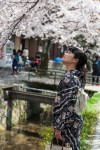It is almost a year since I last posted on this blog. During this time I noted that some bloggers I follow had similarly quiet years and I look forward to again reading your posts when the time is right. Others kept powering on and those I thank for their entertaining posts and inspiration.
This year I want to finish my series on Japan and thought I should start with an iconic subject, hence my choice of kimono – instantly recognisable as Japanese. I have taken a broad approach to my selection of photos by including different types of kimono from the ceremonial to the more lightweight yukata and by showing kimono worn by women of different generations.
Being of the wrong gender and nationality I can only speculate why Japanese women continue to wear kimono and at the risk of being corrected, I suspect that wearing kimono represents a connection to past generations, to Japanese culture and as an affirmation of their nationality. Other reasons might simply be that wearing kimono feels good and is something they like to do.
The opening shots (pics 1 and 2) show two young women engaged in viewing the cherry blossoms and my observation of each was that they were very much “in the moment”. Would wearing western clothing have lessened their experience? Only they would know, but I do know my experience was enhanced by their presence at those locations.
Shichigosan (pic 3) is a Shinto festival where three and seven year old girls in formal dress receive blessings. Unfortunately I arrived late and this is literally the only shot I was able to capture. I see a proud young girl in a splendid kimono posing for a “milestone family album” shot that, in future years, may remind her of a special day in her life. Will this experience encourage her to wear kimono in her later life? Again, only time will tell, but festivals such as Shichigosan provide important opportunities to expose children to their cultural heritage.
The closest I have come to a personal kimono experience is shown at pic 4, where this colourful arrangement occupied a corner of a tatami room at the traditional Japanese house I rented in Hiroshima. Looking at the photo brings back pleasant memories of the stay.
I have included a selection of photos (pics 5 to 8) to show that wearing kimono does not hamper everyday activities such as shopping, with women in several cities shown going about their business. My favourite from this group is the woman doing her Christmas shopping in Dotonbori (pic 5), who encapsulates the Japanese ability to combine the traditional and the contemporary; in this case kimono, modern handbag and cell phone.
One also sees many younger women in kimono, especially during times of celebration such as celebrating the autumn colours (pic 9) or simply enjoying the fantasy of dressing as a geisha for the day (pic 11). I first noticed the elegant woman in pic 12 for the furoshiki she was carrying – a simple square of cloth that can be configured for multiple uses, including carrying goods. Someone else obviously noticed her, but whether wearing kimono or not it would seem that body language tells the story.
I often walked past the teahouse in pic 13 and every time the hostess greeting patrons at the door was smiling. One could not imagine her wearing anything other than kimono. Finally I have chosen to close the post with several photos of a Shinto bride taken at Tokyo’s Meiji Jingu, whose kimono epitomises elegance.
(Please click on any of the following images for an enlarged view.)




























































































